- Scheduling, inventory, and resource management inefficiencies regularly challenge the order-to-dispatch cycle in custom metal and architectural millwork manufacturing.
- A smart Manufacturing Execution System (MES) helps design intelligent production workflow to manage inventory, plan machine maintenance and minimize production hiccups.
- Using real-time, data-backed insights from other enterprise systems an MES software delivers cohesive operations control for enhancing production efficiencies.
Architectural millwork manufacturers and custom metal fabricators face issues stemming from high degree of customization in product design and manufacturing. They are plagued by prioritizing production, poor inventory management and concerns over integrating information across functions.
A tailor-made manufacturing execution system (MES) can radically improve the scenario.
An MES offers real-time visibility into the shop floor to meticulously plan master production schedules for custom architectural millwork and metal fabrication. It can help cut down overstocking/stock-outs, defect rates, job costing, enhance OEE, reduce downtime, and other compliance issues.
The right MES software helps you stay on top of production orders by watching your shop floor live. It streamlines your end-to-end production process from purchase order generation to final dispatch and delivery.
An MES seamlessly integrates with business systems like ERP, CRM, SCM and PLM systems to track KPIs and share data across functions to drive a level of process visibility that is otherwise impossible to achieve.
In this comprehensive guide, we will walk you through the various facets of a robust MES system including features, benefits, modules and business system integrations. We will also help you choose the best-fit MES for your unique business and industry needs.
Table of Contents
- What is a Manufacturing Execution System (MES)?
- Why Implement an MES?
- Core Modules of MES Software
- Add-on Modules of MES Software
- Integrating MES with PLM, ERP, CRM, SCM, and More
- MES vs. ERP: Understanding the Distinction
- Benefits of MES Software for Small and Medium Businesses
- What to Check Before Implementing an MES?
- How the HitechDigital MES works
- How to Get Started on Your MES Journey
- MES: Paving the Path to the Future
- Conclusion
What is a Manufacturing Execution System (MES)?
A Manufacturing Execution System (MES) is a digital system used to track and document production right from purchase order release to finished goods. It connects, monitors, and controls complex manufacturing systems and data flows on the factory floor, ensuring effective execution of manufacturing operations and improving production efficiencies.
MES solution provides real-time monitoring and control of multiple elements of the production process, such as inputs, personnel, machines, and support services. The main goal of an MES software is to optimize the manufacturing process by monitoring, tracking, documenting, and controlling the entire production lifecycle, from order release to product delivery for finished goods.
It collects data about product genealogy, performance, traceability, material management, and work in progress (WIP), among other plant activities, as they occur. This data allows decision-makers to understand the current settings of the factory floor and better optimize the production process.
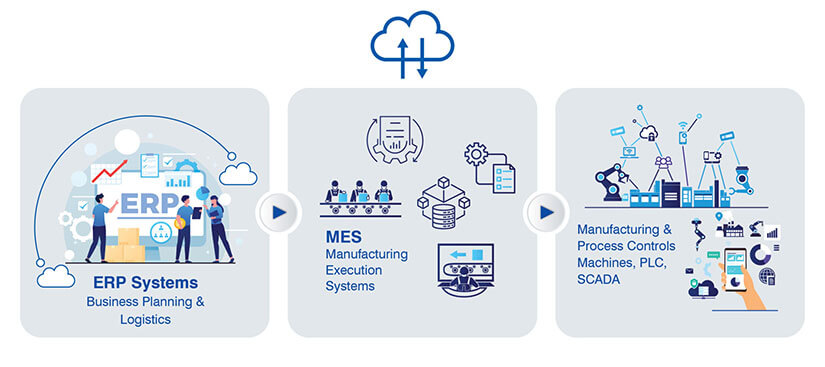
Why Implement an MES?
Complex production scheduling, lack of real-time tracking capabilities, quality control issues, and the need for accurate reporting and analytics pose significant hurdles to architectural millworkers and metal fabricators. An MES helps them overcome these challenges.
Some benefits of implementing an MES software include reduced waste, re-work, and scrap; quicker setup times; more accurate capture of cost information (e.g., labor, scrap, downtime, and tooling); increased uptime; and incorporation of paperless workflow activities.
MES solution also helps eliminate human error in manufacturing by providing real-time quality data checks, yield monitoring, automatic enforcement of specifications and business rules, and as-manufactured lot, batch, device, or unit traceability, resulting in improved product and process quality and higher productivity.
Core Modules of MES Software
1. Production Planning and Scheduling
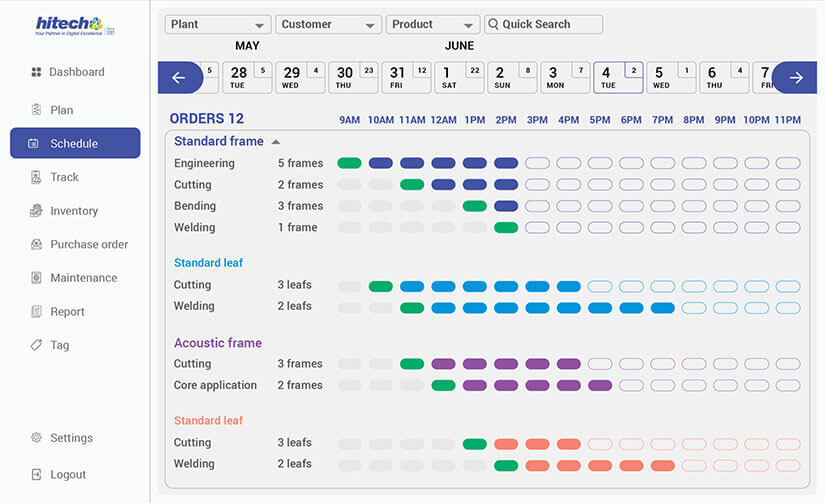
The core functionality of the production planning software lies in in the utilization of advanced algorithms and finite capacity scheduling techniques. For instance, manufacturers can leverage machine learning algorithms to analyze historical production data and predict demand patterns.
By considering factors such as machine capabilities, material availability, and labor constraints, MES system can generate optimized production schedules. MES can even sequence orders based on setup time requirements, minimizing changeovers and maximizing throughput.
This ensures efficient utilization of resources, reduces idle time, and enables just-in-time production strategies.
2. Order Tracking and Tracing
MES provides comprehensive order tracking and tracing capabilities through the integration of barcodes or RFID technology. As each component or product is assigned a unique identifier, manufacturers can track its location and status throughout the production cycle.
For example, when a custom architectural millwork manufacturer receives an order for a set of custom doors, MES system generates a unique barcode for each order.
As the doors move through various stages of production, the production tracking software captures real-time data, allowing manufacturers to track their progress, identify potential bottlenecks, and estimate delivery dates accurately.
3. Quality Management
MES software offers advanced quality management functionalities to ensure adherence to stringent quality standards. Manufacturers can define quality control checkpoints, inspection criteria at critical stages of production and manage issues efficiently.
For example, in custom metal fabrication, an MES can enforce the inspection of welds based on predefined acceptance criteria. MES captures quality data such as measurements, test results, and inspection records.
Statistical process control (SPC) techniques can be applied to analyze this data and identify trends or anomalies. By applying control charts to dimensional measurements, manufacturers also can detect variations and take corrective actions before non-conformities arise.
4. Reporting and Analytics
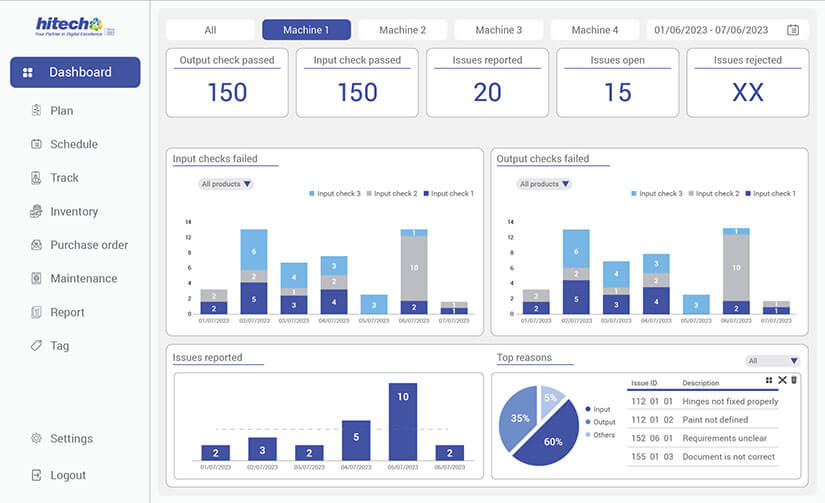
MES software empowers manufacturers with comprehensive reporting and analytics capabilities, allowing them to gain actionable insights from production data.
Manufacturers and fabricators can generate reports and role-based dashboards that provide real-time visibility into key performance metrics such as OEE (Overall Effectiveness), yield, and cycle time. You also get relevant alerts and notifications to take the right actions at the time.
MES solution can also employ advanced analytics techniques, such as machine learning algorithms, to identify patterns or correlations in the data. You can use predictive analytics to forecast equipment failures based on historical maintenance records, enabling proactive maintenance activities.
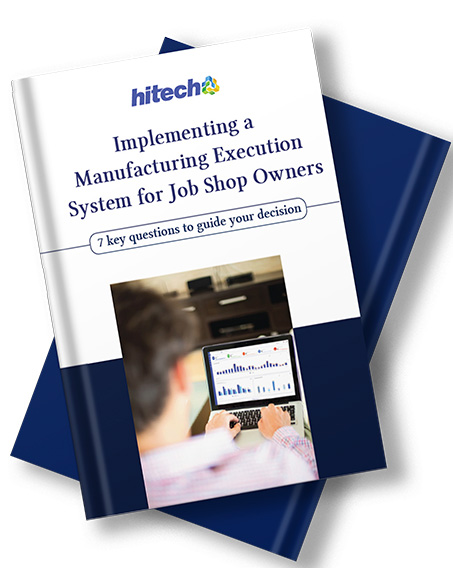
Implementing an MES for job shop owners
- Do you still manually plan production?
- Can you track and trace all manufacturing orders?
- How updated are your reports on machine availability?
- Ask many more questions like this to assess your job shop’s maturity.
Add-on Modules of MES Software
To further enhance efficiency and achieve operational excellence, custom architectural millwork manufacturers and custom metal fabricators usually consider integrating additional functionalities into their MES solutions. Let’s take a look at some add-on functionalities that are often integrated with an MES.
1. Inventory Management

An efficient inventory management system is crucial for manufacturers to optimize production and meet customer demands.
MES software can be enhanced with add-ons such as Radio-Frequency Identification (RFID), Bluetooth Low Energy (BLE), and Industrial Internet of Things (IIoT) capabilities. These technologies enable real-time tracking and monitoring of inventory, ensuring accurate inventory levels and reducing the risk of stock-outs or excess inventory.
By utilizing RFID or BLE tags, manufacturers gain visibility into the movement of materials and products throughout the production floor.
With IIoT, manufacturers can leverage sensor data to monitor environmental conditions, such as temperature and humidity, ensuring optimal storage conditions for perishable or sensitive materials. It can also track components across warehouses and pinpoint the exact location.
2. Purchase Order Management

Streamlining the procurement process is important for manufacturers to optimize their supply chain and improve overall procurement effectiveness.
With a robust purchase order software, manufacturers can automate workflows, increase visibility across the supply chain, and achieve seamless collaboration with suppliers.
MES system integrates with enterprise resource planning (ERP) systems and supplier portals, enabling automated purchase order generation, real-time order status updates, and streamlined communication.
This integration empowers manufacturers to enhance procurement accuracy, reduce lead times, and improve overall supply chain efficiency.
3. Predictive Maintenance Management
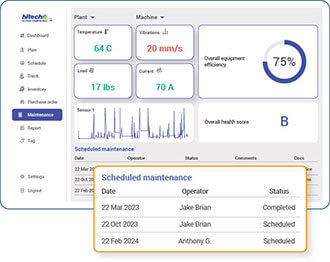
Downtime due to unplanned machine failures can significantly impact production and profitability. Predictive maintenance management software backed by IIoT and predictive analytics prevents and pre-empts machine downtime.
By leveraging sensor data from IIoT-installed devices across the shop floor, manufacturers can monitor machine health, identify potential failure patterns, and schedule maintenance activities within MES system proactively.
Predictive analytics algorithms analyze historical maintenance records and sensor data to identify early warning signs of equipment failure. By implementing predictive maintenance management, manufacturers can optimize maintenance schedules, reduce downtime, and increase equipment reliability.
4. Data-Backed Insights and Decision-Making
MES software can be enriched with add-ons that facilitate comprehensive data reporting, analysis, and decision-making. IoT-installed devices across the shop floor capture real-time data, providing a 360-degree view of production operations.
Manufacturers can leverage this data for reporting and analysis, generating insights into key performance metrics, production trends, and process optimizations.
By utilizing advanced analytics techniques such as machine learning algorithms, manufacturers can identify patterns, correlations, and anomalies in the data. This data-driven decision-making approach enables manufacturers to make informed decisions, optimize processes, and drive continuous improvement.
Make informed decisions with drill down reports
Never make a wrong decision. Get up-to-the minute information into your production operations with custom reports, insights and dashboards.
Integrating MES with PLM, ERP, CRM, SCM, and More
Integrating MES software with other systems such as Product Lifecycle Management (PLM), Enterprise Resource Planning (ERP), Customer Relationship Management (CRM), and Supply Chain Management (SCM) provide a holistic view of the manufacturing process, enhancing efficiency, collaboration, and competitiveness.
The Need for Business Integrations
- Seamless flow of information: MES integrations enable seamless coordination, streamline data flow, and facilitate efficient collaboration across departments and systems. By breaking down data silos and eliminating manual data transfer, businesses achieve improved operational efficiency, enhanced data accuracy, and consistency.
- Real-time visibility: Real-time visibility into production processes, inventory levels, and customer orders empowers businesses to optimize resource allocation, minimize downtime, and reduce lead times.
- Enhanced collaboration: These integrations enhance supplier management and collaboration, enabling effective procurement and streamlined supply chain operations.
- Eliminated data silos: By leveraging integrated data, decision-makers gain comprehensive and timely information for strategic planning and data-driven decision-making. Proactive maintenance activities, compliance with industry regulations, and quality control measures are also facilitated through these integrations.
- Operational excellence: The seamless integration of MES with essential systems empowers businesses to achieve operational excellence, drive continuous improvement, and stay competitive in the dynamic manufacturing landscape.
MES Integration with PLM: Product Lifecycle Management (PLM) focuses on managing product data, development, and collaboration. Integrating MES with PLM enables small businesses to seamlessly transition from design and engineering to production. By sharing critical information such as product specifications, bills of materials, and work instructions, MES-PLM integration ensures that the manufacturing process aligns with design intent and facilitates efficient production planning and execution.
MES Integration with ERP: Enterprise Resource Planning (ERP) systems primarily focus on managing core business processes such as finance, inventory, and human resources. While MES and ERP share some similarities, they serve distinct purposes. MES focuses on shop floor operations, while ERP provides an enterprise-wide view.
Integrating MES with ERP enables small businesses to bridge the gap between the shop floor and the business office, ensuring data synchronization, streamlined communication, and efficient resource allocation.
MES Integration with CRM: Customer Relationship Management (CRM) systems facilitate managing customer interactions, sales, and service.
By integrating MES with CRM, small businesses can enhance customer satisfaction through improved order visibility, accurate delivery dates, and proactive communication. Manufacturers can track and fulfill customer orders efficiently, gaining a competitive edge in delivering exceptional customer experiences.
MES Integration with SCM: Supply Chain Management (SCM) focuses on optimizing the flow of materials, information, and services across the supply chain.
Integrating MES with SCM provides small businesses with end-to-end visibility into their supply chain, enabling proactive inventory management, efficient demand planning, and improved collaboration with suppliers.
By synchronizing production schedules with supplier lead times, manufacturers can reduce stockouts, minimize excess inventory, and ensure timely order fulfillment.
MES vs. ERP: Understanding the Distinction
MES and ERP systems complement each other, each with their own distinct scope and set of functionalities.
| Key differentiator | MES | ERP |
|---|---|---|
| Usage | MES Focuses on the execution and optimization of production processes on the shop floor. | ERP Encompasses broader business functionalities beyond the shop floor. |
| Application | MES Offers real-time visibility into operations to monitor orders, track machine usage, and manage resources. | ERP Provides a unified view of enterprise-wide data for seamless information flow and collaboration. |
| Insights | MES Captures real-time data for machine performance, quality metrics, and material consumption, for analysis. | ERP Gives a consolidated view of periodic bases for longer forecasting and trend analysis. |
| MES Offers insights for every stage of production in real-time. | ERP Offers strategic insights into business performance, decision-making, and resource planning at an enterprise level. | |
| Audience | MES CEOs, Purchase Managers, Plant managers, machine operators etc. personnel related to production | ERP Enterprise resource planner |
MES software integration with PLM, ERP, CRM, and SCM streamlines operations, enhances customer satisfaction and optimizes the supply chain. However, understanding the distinction between MES and ERP is crucial for small businesses to leverage the strengths of each system and unlock their full potential. Embracing these integrations empowers small businesses to navigate the complex tech landscape, overcome operational challenges, and achieve sustainable growth in a competitive industry.
Benefits of MES Software for Small and Medium Businesses
Improved Production Planning and Scheduling
- Optimize resource allocation, minimize downtime, and maximize output.
- Leverage advanced planning tools and real-time data for precise scheduling.
- Enhance coordination between departments and optimize production sequences.
- Enable capacity planning to ensure efficient utilization of resources.
- Incorporate predictive analytics to forecast demand and adjust production schedules accordingly.
- Facilitate agile manufacturing by enabling quick response to changes in customer requirements.
Accurate Order Tracking and Tracing
- Real-time visibility into the progress of orders throughout the production cycle.
- Mitigate delays and bottlenecks through proactive identification and resolution.
- Provide accurate updates to customers, ensuring transparency and satisfaction.
- Track individual components and materials to maintain traceability and meet regulatory compliance.
- Enable dynamic routing and order prioritization based on real-time production data.
- Facilitate real-time communication and collaboration between production teams and customer service.
Robust Quality Management
- Implement standardized quality control processes and inspections.
- Capture detailed quality data to identify deviations and defects promptly.
- Improve product consistency, reduce waste, and enhance overall quality.
- Employ statistical process control (SPC) techniques to monitor and analyze quality metrics.
- Enable root cause analysis to identify the source of quality issues and implement corrective actions.
- Integrate quality data with production data to identify correlations between process parameters and product quality.
Comprehensive Reporting and Analytics
- Generate detailed reports, key performance indicators (KPIs), and visualizations.
- Analyze production trends, identify areas for improvement, and make data-driven decisions.
- Gain insights into resource utilization, equipment performance, and overall productivity.
- Monitor and analyze real-time data to identify process bottlenecks and optimize workflows.
- Facilitate benchmarking against industry standards and best practices.
- Provide predictive analytics to forecast production outcomes and optimize operational efficiency.
Seamless Integration
- Integrate with PLM systems for a smooth transition from design to production.
- Synchronize data and streamline communication between MES and ERP.
- Enhance customer satisfaction through integration with CRM systems for accurate order management.
- Enable seamless data exchange with SCM systems for optimized supply chain planning and execution.
- Integrate with financial systems for real-time cost tracking and financial reporting.
- Facilitate seamless data flow between different departments, eliminating manual data entry and reducing errors.
Enhanced Inventory Management
- Real-time tracking of inventory levels and movement using RFIDs and BLE.
- Optimize inventory control, reduce stockouts, and minimize excess inventory.
- Leverage IIoT capabilities for efficient inventory management with data-driven insights.
- Enable automated replenishment and automatic generation of purchase orders.
- Implement inventory optimization techniques to determine optimal stock levels and reorder points.
- Facilitate just-in-time (JIT) inventory management for improved efficiency and cost savings.
Streamlined Purchase Order Management
- Automate workflows and improve procurement effectiveness.
- Increase visibility across the supply chain and facilitate seamless collaboration.
- Streamline communication with suppliers, reducing lead times and improving overall supply chain efficiency.
- Enable electronic purchase order creation, approval, and transmission.
- Integrate with supplier management systems for vendor performance tracking and evaluation.
- Facilitate supplier collaboration for improved order fulfillment and on-time delivery.
Data-Driven Decision-Making
- Leverage IoT-installed devices for real-time data capture across the shop floor.
- Analyze data for reporting and performance tracking.
- Enable data-backed insights and informed decision-making for process optimization and continuous improvement.
- Utilize advanced analytics techniques such as machine learning and predictive modeling.
- Incorporate business intelligence tools to visualize and communicate data insights effectively.
- Enable real-time monitoring of KPIs to track progress toward operational goals.
Preventive Maintenance and Equipment Reliability
- Utilize IIoT and predictive analytics to predict and prevent machine downtime.
- Implement condition-based maintenance for proactive equipment servicing.
- Reduce unplanned downtime, increase equipment reliability, and optimize maintenance schedules.
- Enable remote monitoring of equipment health and performance.
- Integrate with asset management systems for comprehensive equipment maintenance planning.
- Provide real-time notifications and alerts for maintenance tasks and upcoming service requirements.
Say goodbye to unplanned machine downtimes
Let smart machine data predict downtimes in advance and proactively schedule maintenance.
What to Check Before Implementing an MES?
Determining the suitability of implementing a Manufacturing Execution System (MES) for your custom architectural millwork or custom metal fabrication setup involves careful consideration of several technical factors. To ensure a successful MES implementation, the following aspects need to be thoroughly evaluated:
1. Tech Readiness
Begin by assessing your existing technology infrastructure to gauge its readiness for MES integration. Evaluate the extent to which your current systems rely on manual processes, spreadsheets, or paper-based planning. Identifying any technological gaps and understanding the need for an advanced MES system will be crucial in making an informed decision.
- Evaluate the compatibility of existing MES software vendors with your industry-specific software, such as woodworking design software or metal fabrication CAD/CAM tools, to ensure smooth integration and data transfer.
- Consider the need for real-time data exchange with machine monitoring systems, Programmable Logic Controllers (PLCs), and Supervisory Control and Data Acquisition (SCADA) systems, enabling MES to capture live production data and provide actionable insights.
- Assess the scalability and cloud readiness of your IT infrastructure, evaluating whether it can handle the increased data volume and provide secure access to MES functionalities across multiple locations or devices.
2. People Readiness
The readiness of your workforce is a critical aspect that should not be overlooked. Assess the level of preparedness among your employees for the adoption of MES system. This includes evaluating their training needs, addressing potential resistance to change, ensuring role clarity, and identifying any skill gaps that may require training or development programs.
- Identify the key users of MES, such as production managers, operators, and quality control personnel, and assess their familiarity with MES terminologies, user interfaces, and workflow processes.
- Evaluate the need for training programs on MES navigation, data entry, and reporting tools to ensure a smooth transition and maximize user adoption.
- Consider the involvement of subject matter experts, such as experienced operators or supervisors, to provide insights into process workflows and help customize MES functionalities to match your specific manufacturing requirements.
3. Process Compatibility
Analyzing the maturity level of your manufacturing processes is crucial in determining whether your organization is ready for MES implementation. Identify any process gaps or inefficiencies that may hinder the seamless integration of MES. Assess your current practices and workflows to ascertain their alignment with MES requirements.
- Analyze the level of complexity in your manufacturing processes, evaluating whether MES can handle intricate routing, multi-level bills of materials (BOMs), and dynamic work instructions for custom architectural millwork or metal fabrication.
- Identify the need for advanced scheduling capabilities, such as finite capacity scheduling or sequencing optimization algorithms, to optimize resource allocation and minimize production bottlenecks.
- Assess the integration potential of MES solution with Lean Manufacturing or Six Sigma methodologies, allowing for continuous improvement initiatives and waste reduction strategies.
4. Right Features/Functionalities
Consider the specific features and functionalities that align with the unique requirements of your manufacturing operations. This may include aspects such as production inventory management, supply chain planning, preventive maintenance, and other relevant functionalities.
- Consider the need for real-time analytics dashboards, Key Performance Indicators (KPIs), and Overall Equipment Effectiveness (OEE) calculations to monitor production performance and identify areas for improvement.
- Evaluate the requirement for Material Requirements Planning (MRP) capabilities, enabling accurate demand forecasting, inventory optimization, and procurement planning for raw materials or components.
- Assess the need for Quality Assurance (QA) functionalities, including non-conformance tracking, root cause analysis, and quality metrics reporting, to ensure adherence to customer specifications and industry standards.
By meticulously evaluating these technical factors, you can make an informed decision regarding the suitability of MES for your custom architectural millwork or custom metal fabrication setup.
This assessment will ensure that the implementation of MES system is aligned with your technology infrastructure, workforce readiness, process maturity, and the specific features and functionalities required to optimize your manufacturing operations.
How the HitechDigital MES works
The HitechDigital MES operates by integrating with various shop floor systems, collecting real-time data from machines and operators, and providing a centralized platform for monitoring and controlling manufacturing operations. It offers intuitive dashboards, reporting tools, and analytics capabilities for data-driven decision-making.
The HitechDigital MES includes a seamless integration with the ERP system, facilitating the exchange of production data and status updates. This integration ensures accurate inventory management, order tracking, and financial reconciliation, promoting a synchronized flow of information between operational areas.

Step 1: Plan, Schedule, Track and Manage Inventory
The HitechDigital MES receives production orders from the ERP system, containing vital details such as product specifications, quantities, and due dates. These orders are accurately transmitted to the shop floor, acting as a foundation for the subsequent stages of the workflow.
Based on the received production orders, our MES generates a comprehensive master production schedule, considering resource availability, machine capabilities, and production constraints. This optimization process aims to minimize downtime and maximize production efficiency. It also allows giving insights into purchase order lifecycle from the time it is released to the time it is fulfilled.
A case in point: A woodworking studio wanted to improve their inventory management and quality control processes. By integrating the HitechDigital MES with their material inventory system, they were able to track the availability of different wood types, hardware, and finishes. Our MES also facilitates quality checks at various stages of production, ensuring adherence to design specifications and enhancing overall product quality. Deploy HitechDigital’s smart manufacturing software to unlock manufacturing efficiencies. Book your consultation now!.
Step 2: Resource Allocation and Work Distribution
Enter IIoT. Using the power of technology, the HitechDigital MES allocates resources, including machines, tools, and personnel, to each production order based on availability, skills, and compatibility with the specific requirements. Efficient resource allocation ensures smooth operations and minimizes bottlenecks in production.
Following that, our MES distributes detailed work instructions to operators on the shop floor, encompassing assembly procedures, quality standards, and safety guidelines. These instructions empower operators to perform their tasks accurately and efficiently, ensuring consistent product quality.
At this stage, you can track and trace every operation being performed across shop floor and locate resource across warehouse. It allows you to keep a check on the quality of processes, detect any anomalies or fluctuations in throughputs.
For instance, if a furniture manufacturer wanted to optimize their production processes, they would utilize MES to efficiently manage the fabrication of different furniture components, track material usage, and monitor production progress in real-time. The HitechDigital MES can streamline their assembly lines, reduce waste, and enhance overall productivity, resulting in improved on-time delivery and customer satisfaction. Accomplish your manufacturing goals with the HitechDigital MES. Book your consultation today!
Step 3: Production Monitoring and Maintenance
Our MES collects real-time data for KPIs from machines, sensors, and manual inputs using data acquisition systems. This data captures crucial information on production progress, quality parameters, and material consumption. Real-time data collection enables informed decision-making and enhances process visibility.
The HitechDigital MES also continuously monitors the progress of each production order, comparing it against the scheduled timeline. Any deviations or issues are promptly identified through real-time alerts and notifications. This proactive monitoring allows for timely intervention and corrective actions to ensure production targets are met.
A modular office furniture manufacturer can leverage MES to streamline their production lines and achieve faster turnaround times. The HitechDigital MES will automate the creation and distribution of work instructions, ensuring consistent quality across different modules. By capturing real-time data on production status and material usage, they will be able to optimize their supply chain, minimize errors, and meet tight delivery schedules. Ensure compliance with industry standards. Reach out to our MES team today!
Step 4: Quality Checks and Data Analysis
MES incorporates robust quality assurance measures throughout the production process. It gives real-time data for continuous improvement with customizable reports and dashboard with alerts.
Quality checks are performed at different stages, verifying product conformity against specifications. In case of non-conformities, MES triggers appropriate corrective actions, minimizing the risk of defects and ensuring consistent quality.
Leveraging advanced analytics and statistical techniques, our MES analyzes collected data to extract actionable insights. Historical and real-time data are analyzed to identify trends, patterns, and areas for improvement. Detailed reports and dashboards provide stakeholders with valuable information for decision-making and process optimization.
Elevate your production process quality
Leverage the cutting-edge MES solution to control shop floor processes. Automate manual work and eliminate any chances of errors.
How to Get Started on Your MES Journey
Embarking on your MES system adoption journey as a custom architectural millwork manufacturer or custom metal fabricator requires a systematic approach to ensure a successful implementation. By following these easy-to-follow technical steps, you can lay the foundation for a seamless transition to an MES system tailored to your specific needs:
Requirements Assessment: Begin by conducting a thorough assessment of your manufacturing requirements, goals, and operational challenges.
Consider factors such as production complexity, order volume, quality control, and supply chain management. This assessment will serve as the foundation for selecting an MES solution that addresses your unique business objectives.
Vendor Selection: Research MES solution providers that specialize in serving the custom architectural millwork and custom metal fabrication industries. Evaluate their capabilities, functionality, scalability, and integration options.
Look for vendors with a track record of successful implementations and strong customer support. Engage in detailed discussions with potential vendors to ensure they understand your specific industry requirements.
System Configuration: Collaborate closely with the selected vendor to configure the MES system according to your manufacturing processes, workflows, and data needs.
Define parameters such as shop floor hierarchy, production routing, bill of materials (BOM), work instructions, and quality control measures. The vendor should work closely with your team to ensure accurate mapping of your existing processes into the MES system.
Pilot Implementation: Conduct a pilot implementation to test the MES system in a controlled environment. Select a representative area of your manufacturing facility and deploy the system on a smaller scale.
This allows you to identify any potential challenges or areas for improvement before full-scale deployment. Gather feedback from key users, assess system performance, and make necessary adjustments to optimize the MES configuration.
Training and Change Management: Provide comprehensive training to your workforce to ensure they understand how to effectively utilize the MES system. Train employees on system navigation, data entry, reporting tools, and any specific functionalities tailored to your operations.
Implement change management strategies to address potential resistance to the new system, fostering a culture of acceptance and enthusiasm for the MES implementation.
Remember to engage your workforce throughout the process, addressing their concerns and ensuring they feel empowered to embrace the new technology. A well-executed implementation of an MES system can revolutionize your manufacturing operations, optimize productivity, enhance quality control, and drive overall operational efficiency.
MES: Paving the Path to the Future
The future of Manufacturing Execution Systems (MES) holds tremendous promise as it converges with the transformative power of the Internet of Things (IoT).
Greater integration with IIoT
By seamlessly integrating MES system with IoT technologies, manufacturers can unlock a new era of advanced automation, real-time data collection, predictive analytics, and unparalleled connectivity across the entire manufacturing ecosystem.
This synergy propels custom architectural millwork manufacturers and custom metal fabricators into a realm of optimized production processes, predictive maintenance, and heightened levels of efficiency and productivity.
The integration of MES system with IoT empowers manufacturers with an arsenal of cutting-edge capabilities. Through the deployment of IoT-enabled sensors and devices, critical data is collected in real-time, providing a comprehensive view of the shop floor.
This real-time data equips businesses to make informed decisions swiftly, allowing for timely adjustments to production schedules, resource allocation, and quality control measures. Research shows that businesses leveraging IoT-driven MES solutions achieve a staggering 30% improvement in productivity.
By integrating MES with digital twins, manufacturers can get a more holistic approach to production and further enhance their efficiencies.
Improved predictive analytics
Predictive analytics, another cornerstone of this amalgamation, enables businesses to surpass traditional maintenance practices.
By harnessing the power of ML & AI algorithms and historical performance data, manufacturers can predict potential machine failures, enabling proactive maintenance interventions. This predictive maintenance approach slashes downtime, prevents costly disruptions, and extends the lifespan of critical assets.
Statistically, companies adopting predictive maintenance strategies through MES system integration witness an increased ROI from 3% cost savings and additional revenue of 3%.
Seamless connectivity will add power
The seamless connectivity facilitated by MES and IoT integration fosters a synchronized manufacturing ecosystem.
Real-time data exchange with suppliers, customers, and partners enables efficient supply chain planning, accurate order tracking, and streamlined communication. This interconnectedness fosters collaborative decision-making, promotes seamless production flow, and bolsters customer satisfaction.
Conclusion
The adoption of a tailored Manufacturing Execution System (MES) for custom architectural millwork manufacturers and custom metal fabricators paves the way for significant improvements in production processes, order tracking, quality management, and reporting capabilities.
Embracing the core functionalities and leveraging the additional benefits of MES integration with IoT technologies empowers businesses to attain operational excellence, skyrocket productivity, and surpass customer expectations.
The future of manufacturing has arrived, and those who seize the power of MES software and IoT integration will soar to new heights of success in the evolving landscape of the industry.





